8 Yin Yoga Poses for the Deep Release You Need
This article originally appeared on Yoga Journal
Twists have been said to do a lot of things in yoga, from detox to deep release. While science has debunked the theory that twists wring our organs and therefore detoxify our bodies, Traditional Chinese Medicine suggests twists can bring about deeper release in the subtle energetic body.
Yin Yoga is informed by the Traditional Chinese Medicine principle that there are energetic lines, or meridians, throughout the body. These are similar to the nadis in yoga philosophy. According to Traditional Chinese Medicine, each meridian corresponds to a different organ. Twists can stimulate different meridians, but they most effectively compress the urinary bladder meridian.
To conceptualize how this meridian functions and its potential for energetic release, consider how its corresponding organ functions. Physically, the bladder eliminates what we don't need. Energetically, according to Traditional Chinese Medicine, it's the same.
And just as elimination is a lot harder when we overtax the body with things that aren’t useful, the same is true when we’re holding on to energy we don’t need. Twists, according to this wisdom, provide an opportunity to release all of the energetic crap that doesn't nourish us.
During this Yin Yoga practice, you're given the opportunity to move your body and your energy in various ways, to breathe, and to listen so that you may access what might not be serving you. Then, perhaps you release it--if not forever, at least for a while. If you cannot let it go, breathe, soften, and let it be.
A Yin Yoga practice for deep release
For this practice, it will be helpful to have a bolster (or a couple of sturdy pillows) and two blocks.
Heart Bench
We'll begin the practice in Heart Bench. The way we'll set this up is a bit different than perhaps you have before. Lie back with a bolster under your lower back and a block on its medium level underneath your head. Bring the soles of your feet to the floor with your knees bent. Notice all of the places along your back body that are supported by the floor, bolster, and block and feel for grounding into what’s supporting you. Notice your inhalation and your exhalation. As your body begins to open, you might lower the height of the block under your head to create more opening along the throat. Stay here for 5 minutes.
Mermaid
From Heart Bench, allow your knees to fall over to your left side and let your body go along with it, keeping the bolster underneath your ribs and the block under your head. Your left arm will be cradled in between the block and the bolster. Rest your right arm alongside your right ear and reach your right leg toward the space behind you to create more sensation along the front of your right hip and along your right side. You can increase or decrease the sensation in your right leg by bringing it closer or further from your left knee. Stay here for 3 minutes.
Slowly roll onto your right side and repeat, remembering to adjust the position of your left leg as needed. Stay for 3 minutes on this side.
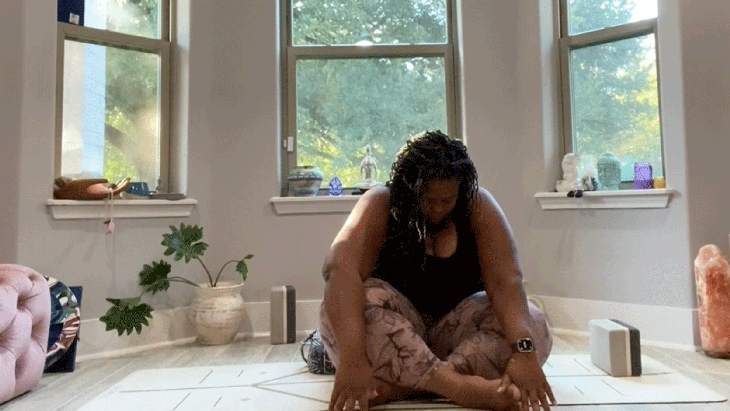
Square Pose
From Mermaid, make your way onto one side and come to all fours. Sit back on your heels so you can feel the effect of the previous poses in your body. Come to a cross-legged seat and stack your right shin on top of your left shin, right knee on top of your left nee. If you feel tightness in the hips, you may place your right foot on a block in front of your left shin to create more space. Alternatively, keep your legs crossed, right leg ahead of your left, if stacking your shins stresses your hips. Lean forward over your crossed or stacked legs. Stay here for 3 minutes.
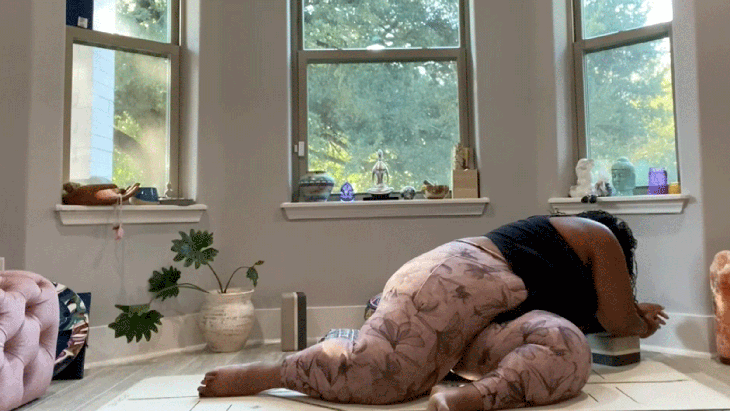
Twisted Deer
From Square, walk your hands back toward your body, unstack or uncross your right leg, and come to seated on your left hip. Bend your knees 90 degrees and draw your right leg towards the space behind you until you notice sensations in the front of your right hip. Press into your hands and lengthen through your spine, then twist over your left thigh or hip. Bend your elbows to bring your forearms to the floor, blocks, or bolster or keep your arms extended straight like kickstands. Find the twist that you're seeking. Stay here for 3 minutes.
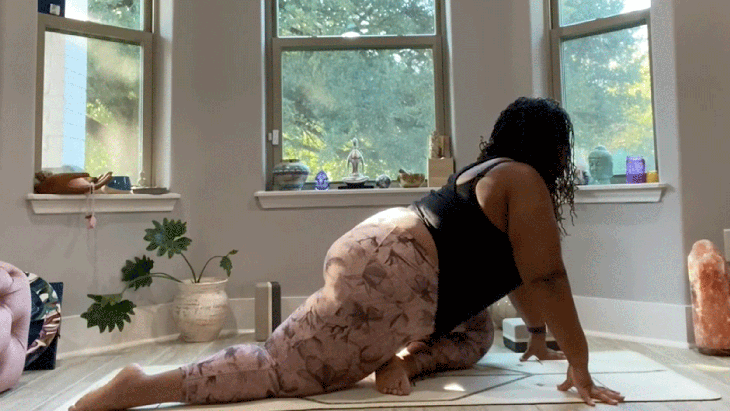
Swan
From Twisted Deer, walk your hands back to center and bring your left knee toward the left side of your mat and draw your left shin toward parallel to the short side of the mat. Extend your right leg long behind you for Swan. You may bring blocks underneath your hands to create more of a backbend here, which will increase sensations along the right hip flexor, as well. Stay for 2 minutes.
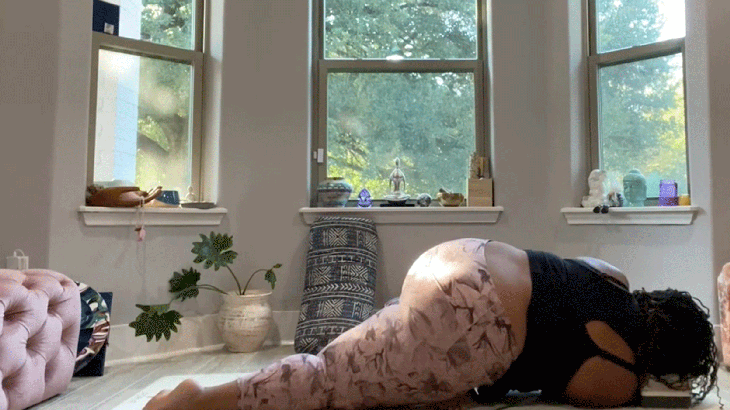
Twisted Swan
From Swan, lift your upper body slightly and thread your right arm under your chest and your left arm, similar to how you twist in Thread the Needle. Draw the left shoulder back to create more of the twist, and wrap your left arm behind your body for Twisted Swan. You might want to bring a block under your head to create more space to accommodate the twist. Take a full inhale and exhale as you sigh it all out. Stay here for up to 3 minutes.
Release and repeat Square Pose with your left leg on top, followed by Twisted Deer, Swan, and Twisted Swan on the other side.
Release to Downward-facing Dog and any other movement that allows you to sense the rebound, or release, in your body.
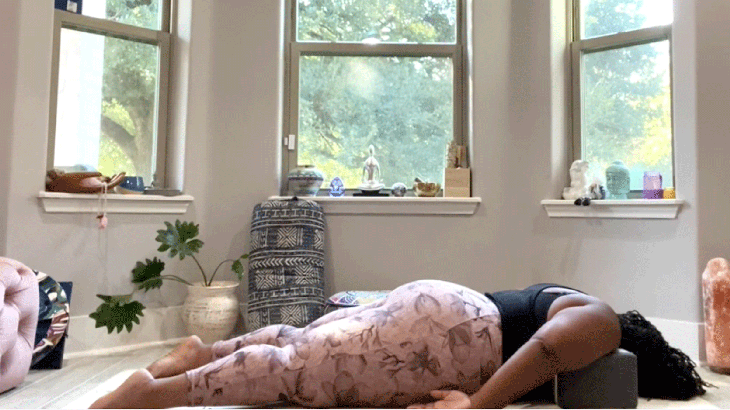
Supported Locust
Come onto your belly and bring a block under each forearm. Finding the right place for the blocks is an individual pursuit, but know that you're creating the shape of a propped-up Salabhasana (Locust Pose). My recommendation is to have the blocks on their medium height supporting the shoulder and upper arm. Your forehead will come to the mat and your legs will extended straight behind you. If the bridge of your nose is long, you may bring a blanket under your forehead to create more space to accommodate it. Let your whole body surrender to gravity. Stay here for 5 minutes.
Slide the blocks off to the side and rest for a moment with your hands stacked underneath your forehead in Supported Crocodile. After a few moments, press back into Child’s Pose and breathe.
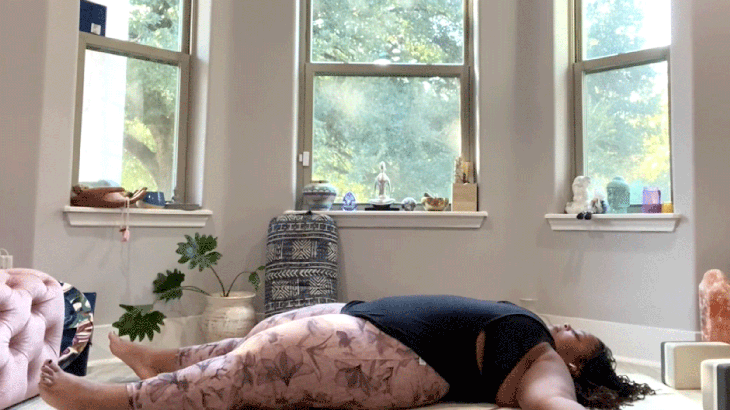
Savasana
From Child’s Pose, make your way into Savasana. Because of all of the twists in this practice, an unsupported Savasana might feel welcome. If it does not, feel free to add props to create all of the conditions of rest you need. Stay here for as long as you like.
See also: More Yin and Restorative practices with Tamika Caston-Milller
About our contributor
Tamika Caston-Miller, E-RYT 500, is the director of Ashe Yoga, where she curates yoga experiences and trainings in service of collective healing and community repair. Having begun her yoga journey in 2001 with a home practice, she now holds advanced certifications and training in Trauma-Informed Yoga, Somatics, Yin Yoga, Restorative Yoga, and Yoga Nidra. Tamika's journey has been informed by chronic pain and injuries, social justice for QTBIPOC communities, the battle between shame and compassion and quest for ancestral healing, and the love for the practice and philosophy of yoga.
For exclusive access to all of our fitness, gear, adventure, and travel stories, plus discounts on trips, events, and gear, sign up for Outside+ today.

